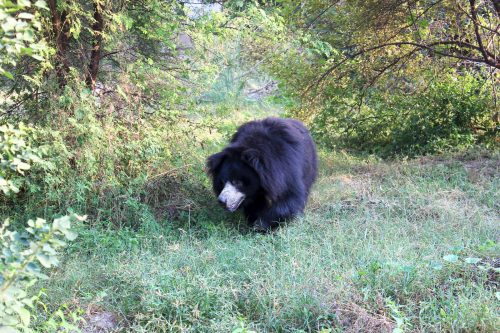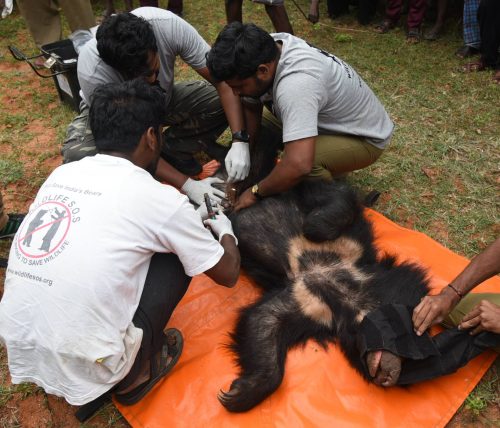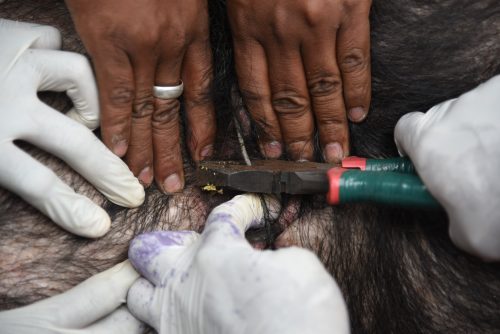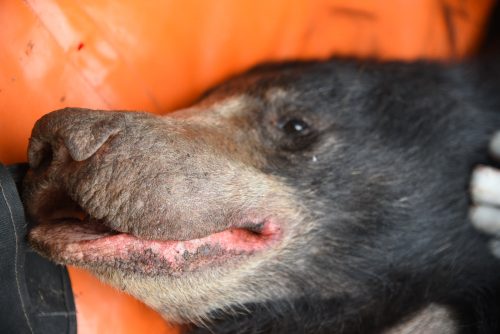TBI Blogs: Organisation Pulls All Stops to Rescue Sloth Bear Caught in Poacher’s Snare in Karnataka
Sloth bears have been declared a 'Vulnerable Species' under the IUCN Red Data List, and are poached for their body parts which are believed to have medicinal value. Wildlife SOS recently rescued a young and healthy sloth bear in Karnataka.

Sloth bears have been declared a ‘Vulnerable Species’ under the IUCN Red Data List, and are poached for their body parts which are believed to have medicinal value. Wildlife SOS recently rescued a young and healthy sloth bear in Karnataka.
The distressed cries of an animal pierced through the stillness of the forest in the early hours of the morning, startling the occupants of Koratagere village. Upon further investigation, they were horrified to find a large sloth bear hiding amidst the bushes with a crude wire snare intertwined around its waist. Fearing for its well-being, the concerned villagers immediately reported the incident to the local Forest Department officials, who in turn contacted the wildlife conservation NGO, Wildlife SOS, for their assistance.
Located in the Madhugiri range of Karnataka, this particular region is home to a significant population of wild sloth bears (melursus ursinus), one of the four unique bear species found in the Indian subcontinent.

They are considered myrmecophageous as they feed primarily on termites, insects, fruits, berries and tubers. Over the years, their population in the wild has been threatened due to loss of habitat, man-animal conflicts and poaching, making them a ‘Vulnerable Species’ under the IUCN Red Data List. They have also been listed under Appendix I of the Convention on International Trade in Endangered Species of Wild Flora and Fauna (CITES).
A six-member rescue team led by Dr Arun A Sha, Director of Wildlife Veterinary Operations at Wildlife SOS, along with Forest Department officials, rushed to the location, with the necessary equipment in hand.
In its attempt to break free, the bear had been struggling for hours causing the metal wire to tighten its grip around the helpless animal’s waist.

According to the team, the snare was made up of a modified clutch wire, reinforced with a fence wire and, judging by the condition of the bear, they suspected it to have been trapped for nearly 15 hours.
They had to act fast and cut through this barbaric hunting device before it caused any severe internal damage to the traumatized bear, which was already under immense pain. Dr. Arun had to first tranquilise the bear in order to cut open the snare and conduct a thorough medical assessment, which was followed by treatment of minor external wounds on its body. The sloth bear was identified as a healthy female, approximately 4 to 5 years of age.
Fortunately, the bear did not sustain any severe injuries, making it possible for the team to release it in the neighboring Thimmalapura State Reserve Forest, where it can continue living a free life in a natural environment.
Meanwhile, the Forest Department is leaving no stone unturned in tracking down those responsible for setting up this illegal hunting device and engaging in poaching of protected wildlife species in the area.

Snares are one of the cruelest human-created threats to wildlife and it is distressing to imagine the millions of animals that fall victim to these barbaric devices every year. Animals caught in these crude, deadly hunting traps often struggle for hours and sometimes even days before succumbing to thirst, hunger, strangulation, internal injuries and even predation from carnivores. Those who manage to escape often succumb to their injuries and die, days or weeks after their painful escape.
There is a major demand in the international black market for body parts such as bones, teeth and claws, which are believed to have medicinal value and magical properties. Additionally, their reproductive organs are used as aphrodisiacs; such blind faith results in exposing this species to several threats and danger.
Sloth bear cubs are captured from the wild at a young age and sold into a life of pain and abuse as ‘dancing bears,’ a barbaric practice that was made illegal in India when the Wildlife Protection Act of 1972 came into effect.

However, innocent cubs are still captured from the wild and the illegal trafficking of sloth bears continues to prevail in and around India.
According to Wildlife SOS co-founder, Kartick Satyanarayan, as an organisation dedicated towards conserving and protecting India’s rich natural heritage and taking action against animal cruelty, Wildlife SOS has and will continue to work towards protecting wild sloth bears that are a constant target of human exploitation. The NGO has been actively involved in educating the public and spreading awareness regarding the illegality of poaching and trade as well as the abominable treatment of these animals, as it is incredibly important to curb cruelty and poaching of wildlife species.
Do your bit for the welfare of animals. Click here to support anti-poaching efforts.
Featured image for representation only. Source: Wikipedia
Like this story? Or have something to share? Write to us: [email protected], or connect with us on Facebook and Twitter.
NEW: Click here to get positive news on Whatsapp!
If you found our stories insightful, informative, or even just enjoyable, we invite you to consider making a voluntary payment to support the work we do at The Better India. Your contribution helps us continue producing quality content that educates, inspires, and drives positive change.
Choose one of the payment options below for your contribution-
By paying for the stories you value, you directly contribute to sustaining our efforts focused on making a difference in the world. Together, let's ensure that impactful stories continue to be told and shared, enriching lives and communities alike.
Thank you for your support. Here are some frequently asked questions you might find helpful to know why you are contributing?


This story made me
-
97
-
121
-
89
-
167














